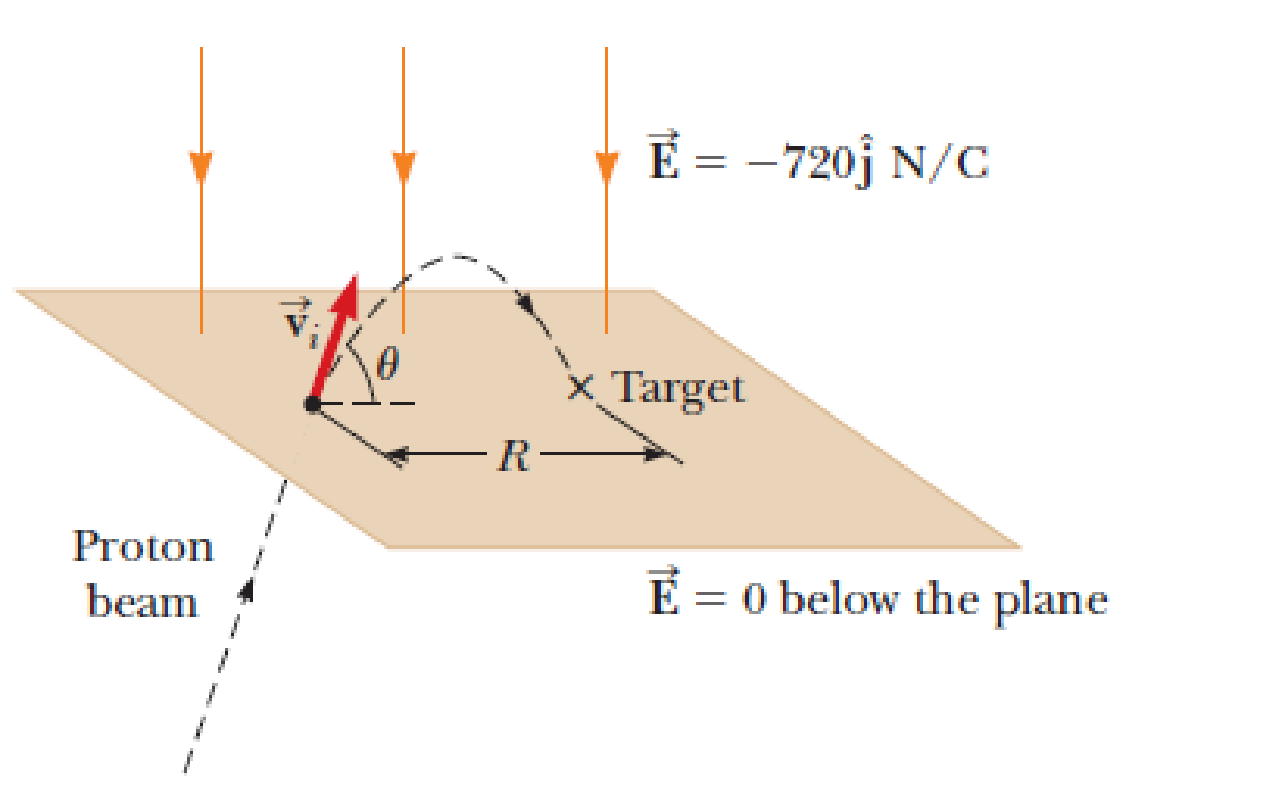
Concept explainers
Protons are projected with an initial speed vi = 9.55 km/s from a field-free region through a plane and into a region where a uniform electric field

Figure P23.54
Want to see the full answer?
Check out a sample textbook solution
Chapter 23 Solutions
Bundle: Physics for Scientists and Engineers with Modern Physics, Loose-leaf Version, 9th + WebAssign Printed Access Card, Multi-Term
- Figure P24.16 shows three charged particles arranged in the xy plane at the coordinates shown, with qA = qB = 3.30 nC and qC = 4.70 nC. What is the electric field due to these particles at the origin? FIGURE P24.16arrow_forwardFigure P24.17 shows a dipole. If the positive particle has a charge of 35.7 mC and the particles are 2.56 mm apart, what is the electric field at point A located 2.00 mm above the dipoles midpoint?arrow_forwardFind an expression for the magnitude of the electric field at point A mid-way between the two rings of radius R shown in Figure P24.30. The ring on the left has a uniform charge q1 and the ring on the right has a uniform charge q2. The rings are separated by distance d. Assume the positive x axis points to the right, through the center of the rings. FIGURE P24.30 Problems 30 and 31.arrow_forward
- Four charged particles are at rest at the corners of a square (Fig. P26.14). The net charges are q1 = q2 = +2.65 C and q3 = q4 = 5.15 C. The distance between particle 1 and particle 3 is r13 = 1.75 cm. a. What is the electric potential energy of the four-particle system? b. If the particles are released from rest, what will happen to the system? In particular, what will happen to the systems kinetic energy?arrow_forwardIn Figure P24.49, a charged particle of mass m = 4.00 g and charge q = 0.250 C is suspended in static equilibrium at the end of an insulating thread that hangs from a very long, charged, thin rod. The thread is 12.0 cm long and makes an angle of 35.0 with the vertical. Determine the linear charge density of the rod. FIGURE P24.49arrow_forwardA positively charged disk of radius R = 0.0366 m and total charge 56.8 C lies in the xz plane, centered on the y axis (Fig. P24.35). Also centered on the y axis is a charged ring with the same radius as the disk and a total charge of 34.1 C. The ring is a distance d = 0.0050 m above the disk. Determine the electric field at the point P on the y axis, where P is y = 0.0100 m above the origin. FIGURE P24.35 Problems 35 and 36.arrow_forward
- Four charged particles are at rest at the corners of a square (Fig. P26.14). The net charges are q1 = q2 = 2.65 C and q3 = q4 = 5.15 C. The distance between particle 1 and particle 3 is r13 = 1.75 cm. a. What is the electric potential energy of the four-particle system? b. If the particles are released from rest, what will happen to the system? In particular, what will happen to the systems kinetic energy as their separations become infinite? FIGURE P26.14 Problems 14, 15, and 16.arrow_forwardA circular ring of charge with radius b has total charge q uniformly distributed around it. What is the magnitude of the electric field at the center of the ring? (a) 0 (b) keq/b2 (c) keq2/b2 (d) keq2/b (e) none of those answersarrow_forwardWhat are the magnitude and direction of a uniform electric field perpendicular to the ground that is able to suspend a particle of mass m = 2.00 g carrying a charge of +6.00 C in midair, assuming gravity and the electrostatic force are the only forces exerted on the particle?arrow_forward
- A Two positively charged particles, each with charge Q, are held at positions (a, 0) and (a, 0) as shown in Figure P23.73. A third positively charged particle with charge q is placed at (0, h). a. Find an expression for the net electric force on the third particle with charge q. b. Show that the two charges Q behave like a single charge 2Q located at the origin when the distance h is much greater than a. Figure P23.73 Problems 73 and 74.arrow_forwardaA plastic rod of length = 24.0 cm is uniformly charged with a total charge of +12.0 C. The rod is formed into a semicircle with its center at the origin of the xy plane (Fig. P24.34). What are the magnitude and direction of the electric field at the origin? Figure P24.34arrow_forwardAn electron is in a uniform upward-pointing electric field. a. If the electron experiences a downward acceleration of 9.81 m/s2, what is the magnitude of the electric field? (Ignore gravity.) b. What is the gravitational force on this electron? Is it okay to ignore gravity? Explain.arrow_forward
 Principles of Physics: A Calculus-Based TextPhysicsISBN:9781133104261Author:Raymond A. Serway, John W. JewettPublisher:Cengage Learning
Principles of Physics: A Calculus-Based TextPhysicsISBN:9781133104261Author:Raymond A. Serway, John W. JewettPublisher:Cengage Learning Physics for Scientists and Engineers: Foundations...PhysicsISBN:9781133939146Author:Katz, Debora M.Publisher:Cengage Learning
Physics for Scientists and Engineers: Foundations...PhysicsISBN:9781133939146Author:Katz, Debora M.Publisher:Cengage Learning

